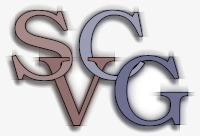Geometric Modelling
headed by Prof. Dr. Jiří Kosinka
Geometric modelling is, at its core, concerned with shape representation. As shapes can be very varied, e.g., in terms of their topological and/or geometric complexity, it is important for shape representation methods to be as flexible as possible. In our research group, we focus on smooth curve and surface representation, using various forms of spline and subdivision methods.
Geometric modelling finds applications in several related areas including Computer Graphics, Computer-Aided Design, and Numerical Analysis, as detailed below.
Computer Graphics
In the area of computer graphics, we have investigated several mesh smoothing methods in order to turn a polygonal manifold mesh into a visually smooth surface. This involves the use of generalised barycentric coordinates, i.e., a generalisation of the standard (triangular) barycentric coordinates to arbitrary (convex) polygons. Moreover, we have presented a method for efficient generation of these surfaces on modern GPUs using hardware tessellation.

We have also looked into how to introduce (semi-)sharp creases into smooth subdivision and NURBS representations, and how to improve the visual quality of subdivision via subdivision shading.
Computer-Aided Design (CAD)
CAD systems are typically based on the B-rep (boundary representation) paradigm with many NURBS (non-uniform rational B-spline) patches which are trimmed and topologically stitched together to form the outer shell (surface) of a 3D model. As these models are typically not even water-tight, they need to be converted to a different representation to meet the requirements of down-stream applications, including numerical analysis. To this end, we investigate conversion methods which consume a CAD model and produce a water-tight approximation of it, using for example Clough-Tocher splines or (non-uniform) subdivision surfaces.
In a different research line, we investigate (rational) curve/surface representations such that their offsets or envelopes still remain rational. This is an important class of shapes (PH curves and PN surfaces) whose offsets can be exactly represented in a CAD system, which is in general not the case due to the fact that offsetting generically introduces square roots into the representation due to normalisation.
Numerical Analysis
As mentioned above, when numerical analysis needs to be performed on a CAD model, the model typically needs to undergo a certain conversion process. Until very recently, this typically involved a triangulation/tetrahedralisation step to prepare the model for the finite element method (FEM). But since the iso-geometric approach was introduced a few years ago, in which the same (smooth) basis functions used to represent the geometry also span the solution space, numerical quadrature rules for various spline and subdivision methods have come into the spotlight.
In our group, we investigate efficient (and where possible optimal) numerical quadrature rules to support the isogeometric approach also on spaces generated using e.g. Clough-Tocher or Powell-Sabin macro-elements, or surface subdivision methods.
